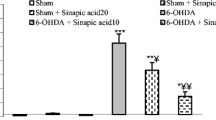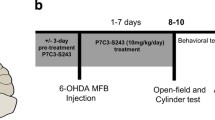Abstract
In this study, we investigated the neuroprotective effect of a benzylideneacetophenone derivative, JC3, in a mouse model of 1-methyl-4-phenyl-1,2,3,6-tetrahydropyridine (MPTP)-induced Parkinson’s disease (PD). C57BL/6 mice were treated with MPTP (30 mg/kg, i.p.) for 5 consecutive days. JC3 (10 mg/kg, i.p.) treatment was initiated 2 h after the first administration of MPTP and then at 24-h intervals for 3 consecutive days. The mice were sacrificed for analyses 7 days after the last MPTP injection. Immunohistochemistry and Western blot were used to determine the expression levels of tyrosine hydroxylase (TH), dopamine transporter (DAT), OX-42 (a marker of microglial activation), and glial fibrillary acid protein (GFAP, a marker of astrocyte activation) in the substantia nigra (SN) and striatum (ST). The results of these experiments demonstrated that JC3 restored the decreased TH-immunoreactivity (IR) and DAT and JC3 attenuated the increase in OX-42, GFAP, and COX-2 on the SN and ST on day 7 post-MPTP injection. These results suggest that JC3 can be a neuroprotective agent in an MPTP-induced model of PD.
Similar content being viewed by others
References
Aloisi, F., The role of microglia and astrocytes in CNS immune surveillance and immunopathology. Adv. Exp. Med. Biol., 468, 123–133 (1999).
Blum, D., Torch, S., Lambeng, N., Nissou, M., Benabid, A. L., Sadoul, R., and Verna, J. M., Molecular pathways involved in the neurotoxicity of 6-OHDA, dopamine and MPTP: contribution to the apoptotic theory in Parkinson’s disease. Prog. Neurobiol., 65, 135–172 (2001).
Castano, A., Herrera, A. J., Cano, J., and Machado, A., The degenerative effect of a single intranigral injection of LPS on the dopaminergic system is prevented by dexamethasone, and not mimicked by rh-TNF-alpha, IL-1beta and IFN-gamma. J. Neurochem., 81, 150–157 (2002).
Chen, Y. and Swanson, R. A., Astrocytes and brain injury. J. Cereb. Blood Flow Metab., 23, 137–149 (2003).
Ciliax, B. J., Drash, G. W., Staley, J. K., Haber, S., Mobley, C. J., Miller, G. W., Mufson, E. J., Mash, D. C., and Levey, A. I., Immunocytochemical localization of the dopamine transpoter in human brain. J. Comp. Neurol., 409, 38–56 (1999).
Dai, Y. Q., Jin, D. Z., Zhu, X. Z., and Lei, D. L., Triptolide inhibits COX-2 expression via NF-kappa B pathway in astrocytes. Neurosci. Res., 55, 154–160 (2006).
Dehmer, T., Lindenau, J., Haid, S., Dichgans, J., and Schulz, J. B., Deficiency of inducible nitric oxide synthase protects against MPTP toxicity in vivo. J. Neurochem., 74, 2213–2216 (2000).
Dong, Y. and Benveniste, E. N., Immune function of astrocytes. Glia, 36, 180–190 (2001).
Herdegan, T., Fischer, G., and Bold, B. G., Immunophilin ligands as a novel treatment of neurological disorders. Trends Pharmacol. Sci., 21, 3–5 (2000).
Gehrmann, J., Matsumoto, Y., and Kreutzberg, G. W., Microglia: intrinsic immuneffector cell of the brain. Brain Res. Brain Res. Rev., 20, 269–287 (1995).
Giovannini, M. G., Scali, C., Prosperi, C., Bellucci, A., Vannucchi, M. G., Rosi, S., Pepeu, G., and Casamenti, F., Beta-amyloid-induced inflammation and cholinergic hypofunction in the rat brain in vivo: involvement of the p38MAPK pathway. Neurobiol. Dis., 11, 257–274 (2002).
Fahn, S. and Cohen, G., The oxidant stress hypothesis in Parkinson’s disease: evidence supporting it. Ann. Neurol., 32, 804–812 (1992).
Ferger, B., Leng, A., Mura, A., Hengerer, B., and Feldon, J., Genetic ablation of tumor necrosis factor-alpha (TNF-alpha) and pharmacological inhibition of TNF-synthesis attenuates MPTP toxicity in mouse striatum. J. Neurochem., 89, 822–833 (2004).
Geng, X., Tian, X., Tu, P., and Pu, X., Neuroprotective effects of echinacoside in the mouse MPTP model of Parkinson’s disease. Eur. J. Pharmacol., 564, 66–74 (2007).
Gerlach, M. and Riederer, P., Animal models of Parkinson’s disease: an empirical comparison with the phenomenology of the disease in man. J. Neural. Transm., 103, 987–1041 (1996).
Heikkila, R. E., Sieber, B. A., Manzino, L., and Sonsalla, P. K., Some features of the nigrostriatal dopaminergic neurotoxin 1-methyl-4-phenyl-1,2,3,6-tetrahydropyridine (MPTP) in the mouse. Mol. Chem. Neuropathol., 10, 171–183 (1989).
Hayley, S., Crocker, S. J., Smith, P. D., Shree, T., Jackson-Lewis, V., Przedborski, S., Mount, M., Slack, R., Anisman, H., and Park, D. S., Regulation of dopaminergic loss by Fas in a 1-methyl-4-phenyl-1,2,3,6-tetrahydropyridine model of Parkinson’s disease. J. Neurosci., 24, 2045–2053 (2004).
Hirsch, E. C., Graybiel, A. M., and Agid, Y. A., Melanized dopaminergic neurons are differentially susceptible to degeneration in Parkinson’s disease. Nature, 334, 345–348 (1988).
Hirsch, E. C., Hunot, S., Damier, P., and Faucheux, B., Glial cells and inflammation in Parkinson’s disease: a role in neurodegeneration? Ann. Neurol., 44, S115–S120 (1998).
Hunot, S. and Hirsch, E. C., Neuroinflammatory processes in Parkinson’s disease. Ann. Neurol., 53,Suppl 3:S49–58; discussion S58–60 (2003).
Jenner, P. and Olanow, C. W., Understanding cell death in Parkinson’s disease. Ann. Neurol., 44, S72–84 (1998).
Kang, J. M., Park, H. J., Choi, Y. G., Choe, I. H., Park, J. H., Kim, Y. S., and Lim, S., Acupuncture inhibits microglial activation and inflammatory events in the MPTP-induced mouse model. Brain Res., 1131, 211–219 (2007).
Kitamura, Y., Itano, Y., Kubo, T., and Nomura, Y., Suppressive effect of FK-506, a novel immunosuppressant, against MPTP-induced dopamine depletion in the striatum of young C57BL/6 mice. J. Neuroimmunol., 50, 221–224 (1994).
Kim, W. G., Mohney, R. P., Wilson, B., Jeohn, G. H., Liu, B., and Hong, J, S., Regional difference in susceptibility to lipopolysaccharide-induced neurotoxicity in the rat brain: role of microglia. J. Neurosci., 20, 6309–6316 (2000).
Kohutnicka, M., Lewandowska, E., Kurkowska-Jastrzebska, I., Czlonkowski, A., and Czlonkoeska, A., Microglial and astrocytic involvement in a murine model of Parkinson’s disease induced by 1-methyl-4-phenyl-1,2,3,6-tetrahydropyridine (MPTP). Immunopharmacology, 39, 167–180 (1998).
Kurosaki, R., Muramatsu, Y., Kato, H., and Araki, T., Biochemical, behavioral and immunohistochemistry alterations in MPTP-treated mouse model of Parkinson’s disease. Pharmacol. Biochem. Behav., 78, 143–153 (2004).
Kurkowska-Jastrzebska, I., Wronska, A., Kohutnicka, M., Czlonkowski, A., and Czlonkowska, A., The inflammatory reaction following 1-methyl-4-phenyl-1,2,3, 6-tetrahydropyridine intoxication in mouse. Exp. Neurol., 156, 50–61 (1999).
Langston, J. W., Ballard, P., Tetrud, J. W., and Irwin, I., Chronic Parkinsonism in humans due to a product of meperidineanalog synthesis. Science, 219, 979–980 (1983).
Liberatore, G. T., Jackson-Lewis, V., Vukosavic, S., Mandir, A.S., Vila, M., McAuliffe, W. G., Dawson, V. L., Dawson, T. M., and Przedborski, S., Inducible nitric oxide synthase stimulates dopaminergic neurodegeneration in the MPTP model of Parkinson disease. Nat. Med., 5, 1403–1409 (1999).
Liu, B., Du, L., and Hong, J. S., Naloxone protects rat dopaminergic neuros against inflammatory damage through inhibition of microglia activation and superoxide generation. J. Pharmacol. Exp. Ther., 293, 607–617 (2000).
Matsuura, K., Makino, H., and Ogawa, N., Cyclosporin A attenuates the decrease in tyrosine hydroxylase immunoreactivity in nigrostriatal dopaminergic neurons and in striatal dopamine content in rats with intrastriatal injection of 6-hydroxydopamine. Exp. Neurol., 146, 526–535 (1997).
Oh, S., Jang, S., Kim, D., Han, I. O., and Jung, J. C., Synthesis and evaluation of biological properties of benzylideneacetophenone derivatives. Arch. Pharm. Res., 29, 469–475 (2006).
Snyder, S. H., Sabatini, D. M., Lai, M. M., Steiner, J. P., Hamilton, G. S., and Suzdak, P. D., Neural actions of immunophilin ligands. Trends Pharmacol. Sci., 19, 21–26 (1998).
Streit, W. J., Graeber, M. B., and Kreutzberg, G. W., Functional plasticity of microglia: a review. Glia, 1, 301–307 (1988).
Tanji, H., Araki, T., Nagasawa, H., and Itoyama, Y., Differential vulnerability of dopamine receptors in the mouse brain treated with MPTP. Brain. Res., 824, 224–231 (1998).
Tipton, K. F. and Singer, T. P., Advances in our understanding of the mechanisms of the neurotoxicity of MPTP and related compounds. J. Neurochem., 61, 1191–1206 (1993).
Turski, L., Bressler, K., Rettig, K. J., Loschmann, P. A., and Wachtel, H., Protection of substantia nigra from MPP+ neurotoxicity by N-methyl-D-aspartate antagonists. Nature, 349, 414–418 (1991).
Tzeng, S. F., Hsiao, H. Y., and Mak, O. T., Prostaglandins and cyclooxygenases in glial cells during brain inflammation. Curr Drug Targets Inflamm. Allergy, 4, 335–340 (2005).
Viale, G., Gambacorta, M., Coggi, G., Dell’Orto, P., Milani, M., and Doglioni, C., Glial fibrillary acidic protein immunoreactivity in normal and diseased human breast. Pathol. Anat. Histopathol., 418, 339–348 (1991).
Vijitruth, R., Liu, M., Choi, D. Y., Nguyen, X. V., Hunter, R. L., and Bing, G., Cyclooxygenase-2 mediates microglial activation and secondary dopaminergic cell death in the mouse MPTP model of Parkinson’s disease. J. Neuroinflammation, 3, 6 (2006).
Vodovotz, Y., Bogdan, C., Paik, J., Xie, Q. W., and Nathan, C., Mechanisms of suppression of macrophage nitric oxide release by transforming growth factor beta. J. Exp. Med., 178, 605–613 (1993).
Wang, T., Pei, Z., Zhang, W., Liu, B., Langenbach, R., Lee, C., Wilson, B., Reece, J. M., Miller, D, S., and Hong, J. S., MPP+-induced COX-2 activation and subsequent dopaminergic neurodegeneration. FASEB J., 19, 1134–1136 (2005).
Wu, D. C., Jackson-Lewis, V., Tieu, K., Tesimann, P., Vadseth, C., Choi, D. K., Ischiropoulos, H., and Przedborski, S., Blockade of microglial activation is neuroprotective in the 1-methyl-4-phenyl-1,2,3,6-tetrahydropyridine mouse model of Parkinson’s disease. J. Neurosci., 22, 1763–1771 (2002).
Zuddas, A., Fascetti, F., Corsini, G. U., and Piccardi, M. P., In brown Norway rats, MPP+ is accumulated in the nigrostriatal dopaminergic terminals but it is not neurotoxic: a model of natural resistance to MPTP toxicity. Exp. Neurol., 127, 54–61 (1994).
Author information
Authors and Affiliations
Corresponding author
Rights and permissions
About this article
Cite this article
Kang, J.M., Jung, JC., Kim, H. et al. Neuroprotective effect of benzylideneacetophenone derivative on the MPTP model of neurodegeneration in mice. Arch. Pharm. Res. 31, 1098–1107 (2008). https://doi.org/10.1007/s12272-001-1275-5
Received:
Revised:
Accepted:
Published:
Issue Date:
DOI: https://doi.org/10.1007/s12272-001-1275-5




